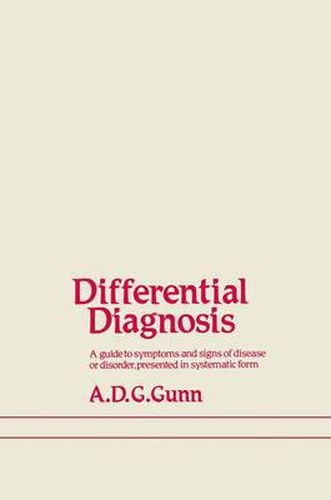Readings Newsletter
Become a Readings Member to make your shopping experience even easier.
Sign in or sign up for free!
You’re not far away from qualifying for FREE standard shipping within Australia
You’ve qualified for FREE standard shipping within Australia
The cart is loading…






This title is printed to order. This book may have been self-published. If so, we cannot guarantee the quality of the content. In the main most books will have gone through the editing process however some may not. We therefore suggest that you be aware of this before ordering this book. If in doubt check either the author or publisher’s details as we are unable to accept any returns unless they are faulty. Please contact us if you have any questions.
This book is designed for use by medical students, nurses, young practitioners, internists, family physicians and all those initially involved with the problem of diagnostics. It is struc tured to provide a concise logical approach to the diagnosis of common illness and disorders in adults. The elucidation of an illness cause is not easy for the inexperienced. Although text books and guidance notes can be referred to for clarification of assembled thought - once a medical history has been taken - a system-orientated reference guide has considerable value for aiding and checking the logic of diagnosis. It is hoped that this book will fulfil that purpose. It could not have been written without the help of R. G. Brackenridge’s Essential Medicine (1979, MTP, Lancaster, England), and J. Fry’s Common Diseases (1979, MTP, Lancaster, England), to which the reader is referred and to which generous acknow ledgement is made. The tables of Differential Diagnosis that follow Chapters 3-7 are adapted from some that have appeared in Handbook of Differential Diagnosis, vols 1-3, published by Rocom Press, Hoffman La Roche Inc. , New Jersey, 1968-1974 - an invaluable publication now unfortun ately out of print, and permission to do so is gratefully apprec- 7 8 DIFFERENTIAL DIAGNOSIS iated. Finally without the stimulus and encouragement of Mr David Bloomer (MTP) and the particular assistance of Mrs J. C. Robinson, this book would never have been written. ALEXANDER D. G.
$9.00 standard shipping within Australia
FREE standard shipping within Australia for orders over $100.00
Express & International shipping calculated at checkout
This title is printed to order. This book may have been self-published. If so, we cannot guarantee the quality of the content. In the main most books will have gone through the editing process however some may not. We therefore suggest that you be aware of this before ordering this book. If in doubt check either the author or publisher’s details as we are unable to accept any returns unless they are faulty. Please contact us if you have any questions.
This book is designed for use by medical students, nurses, young practitioners, internists, family physicians and all those initially involved with the problem of diagnostics. It is struc tured to provide a concise logical approach to the diagnosis of common illness and disorders in adults. The elucidation of an illness cause is not easy for the inexperienced. Although text books and guidance notes can be referred to for clarification of assembled thought - once a medical history has been taken - a system-orientated reference guide has considerable value for aiding and checking the logic of diagnosis. It is hoped that this book will fulfil that purpose. It could not have been written without the help of R. G. Brackenridge’s Essential Medicine (1979, MTP, Lancaster, England), and J. Fry’s Common Diseases (1979, MTP, Lancaster, England), to which the reader is referred and to which generous acknow ledgement is made. The tables of Differential Diagnosis that follow Chapters 3-7 are adapted from some that have appeared in Handbook of Differential Diagnosis, vols 1-3, published by Rocom Press, Hoffman La Roche Inc. , New Jersey, 1968-1974 - an invaluable publication now unfortun ately out of print, and permission to do so is gratefully apprec- 7 8 DIFFERENTIAL DIAGNOSIS iated. Finally without the stimulus and encouragement of Mr David Bloomer (MTP) and the particular assistance of Mrs J. C. Robinson, this book would never have been written. ALEXANDER D. G.